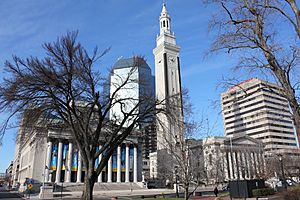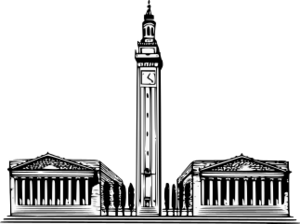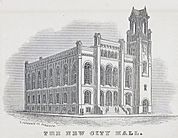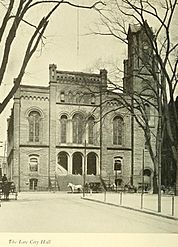Springfield Municipal Group facts for kids
Quick facts for kids Springfield Municipal Group |
|
|---|---|

Springfield Municipal Group, with Symphony Hall to the left and City Hall to the right of the Campanile tower
|
|
| General information | |
| Status | Complete |
| Type | Office Indoor theatre |
| Location | 34-36 Court Street, Springfield, Massachusetts |
| Coordinates | 42°06′04″N 72°35′24″W / 42.101106°N 72.590116°W |
| Construction started | 1911 |
| Completed | 1913 |
| Height | |
| Roof | 300 ft (91 m) |
| Technical details | |
| Floor count | 4 10 (campanile) |
| Design and construction | |
| Architect | Pell & Corbett |
| Developer | A. E. Stephens Company, of New York |
| Engineer | Hollis French & Allen Hubbard |
The Municipal Group in Springfield, Massachusetts is a set of three important buildings in the city center. These buildings include a concert hall, the City Hall, and a tall clock tower. Together, they form a key place for government and cultural events in Springfield.
The buildings show off a special style of architecture called City Beautiful. This style became popular in the early 1900s, thanks to architects like Daniel Burnham from Chicago.
Exploring the Municipal Group's Design
The Municipal Group is located between Court and Pynchon Streets. It has two main buildings built in the Greek Revival style. One is City Hall, and the other is Symphony Hall, which was first called the Municipal Auditorium.
In the middle of these two buildings stands the 300-foot (91 m) Italian-style Campanile clock tower. This tower has twelve bells that play parts of Handel's famous Messiah. The clock face is very large, about fourteen feet wide. When the buildings were first made, the clock and elevator in the tower used water power to work!
The Municipal Group faces Court Square and the historic Old First Church.
Discovering Symphony Hall
 |
|
| Former names | Municipal Auditorium |
|---|---|
| Address | One Columbus Center Springfield, Massachusetts United States |
| Type | Performing arts center |
| Capacity | 2,611 |
| Opened | December 1913 |
Symphony Hall is a large concert venue at the south end of the complex. It was built between 1911 and 1913. It was first known as "The Auditorium."
Symphony Hall is famous for its great sound quality and its beautiful Greek Revival design. It can seat 2,611 people today. It used to hold more, but it has been updated to be more comfortable.
The hall was renamed Symphony Hall in the 1940s. This happened after the Springfield Symphony Orchestra started performing there often. Many different events take place here. These include Broadway-style shows, programs for children, and talks by famous speakers. The yearly ceremony for the Naismith Memorial Basketball Hall of Fame also happens here.
Symphony Hall was updated in 1980 and again in 2004.
A Look Back at History
In 1905, Springfield's first city hall building was destroyed by a fire. People say a monkey accidentally knocked over a kerosene lamp, which caused the fire. Springfield was a very important industrial city back then. So, the city decided to build a grand new set of municipal buildings.
The new Municipal Group was finished in 1913. Former Mayor John A. Denison and President William Howard Taft were there for the opening. On December 8, 1913, President Taft called the Springfield Municipal Group "one of the most distinctive civic centers in the United States, and indeed the world."
For many years, the Municipal Group was the most recognizable symbol of Springfield. After both World War I and World War II ended, the bells in the tower rang out to celebrate with happy crowds.
The Campanile tower was the tallest building in Springfield for a long time. This was because of a law passed in 1908 that limited building heights. It remained the tallest until 1973.
Over time, as the city faced challenges, the Municipal Group also started to show its age. It became very expensive to heat and cool the buildings. Symphony Hall stayed in good condition because of the money from performances. However, City Hall and especially the Campanile tower needed a lot of work.
The bells in the Campanile stopped working because of old electrical systems. The tower itself became unstable, and parts of it were closed off. The clocks on the tower often showed the wrong time. Sometimes, small pieces would fall from the tower.
In 2006, the city decided to invest money to fix up the entire Municipal Group. This included major repairs for the Campanile tower. The city's finances improved, which allowed them to pay for these important renovations.




